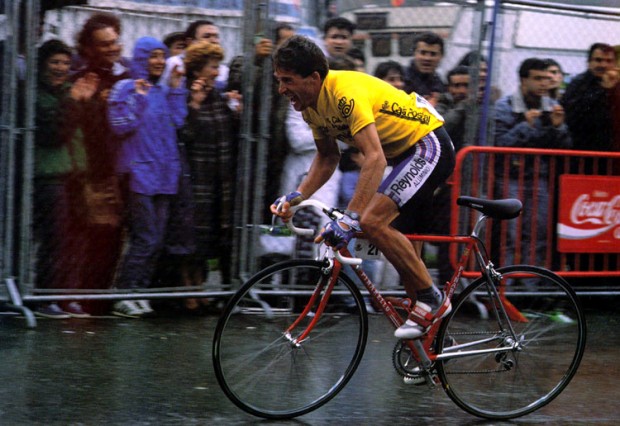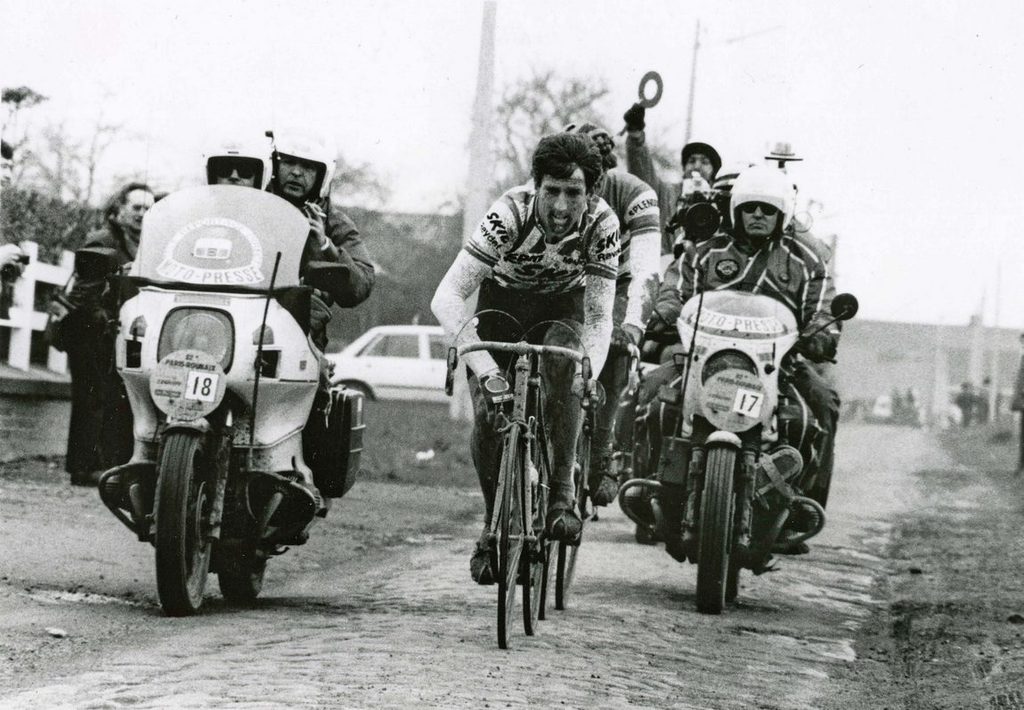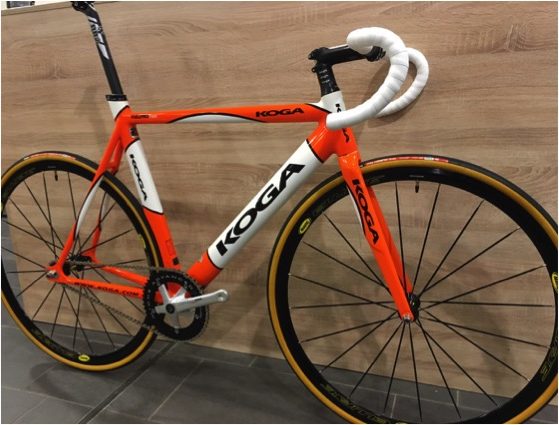Guest Article: Where did all the Time Go?

There has been a lot of talk lately about shoes: the While Ladies, the Yellow Princesses, and the safety and reliability of Spinal Tap Black. But shoe color has not always been a choice, and it is with this premise that fellow community member Jarvis has contributed the following article for our consideration.
He commented to me during our communication about the article that finding the Velominati felt like he was finding his home. Indeed, even a quick scan of this article reveals a lifelong passion for the finer details in this great sport of ours; this is indeed a Velominatus. Here Jarvis covers the origins of the White Ladies, and what has happened to the company that was bold enough to present a white shoe during a time that black leather was the only choice.
Welcome home, son.
—
Look at the peloton today, or more specifically at their feet, and it’s a sea of white shoes, so much so that black shoes look out of place – even wrong. But this wasn’t always the case; go back just over twenty years and you’ll reach the dawn of the White Cycling Shoe. In the late 1980’s, if you wanted anything other than black shoes you had a choice from about three manufacturers; if, however, you wanted white shoes you had one option, Time.
First appearing around 1987, Time produced a black shoe – albeit black leather with grey mesh – twin red straps with a red “go faster” stripe – but they also produced a white version as an alternative. As modern as the black shoe looked in comparison with the other shoes of the day, the white version was the striking number; the uppers were white with the same twin red straps and side stripe, the polycarbonate soles were white with a red heel rubber. It’s difficult to find a definitive history, but my understanding is that Time had intended, or at least expected, the black shoe to be the bigger seller, Pedro Delgado can be seen wearing the black version in the ’88 Tour de France but by the end of the race he was wearing the white version and it was the white shoe that the professionals chose. Either way, the white shoe revolution was taking off and by the following year Time sponsoring not just individual riders as before, but whole teams such as Buckler and Helvetia La Suisse.
It was around this time that I became obsessed with Time products; with the technology of the pedals designed to minimise harm to the knees, and with their modern designs. Most other shoes of the era were full leather with perforations in for cooling, a method that had been around for decades, and were tightened with laces or small Velcro straps. For the aesthete, Time shoes were a revolution, they were almost a perfect design: simple, clean lines, with bold contrasting colours matched to modern technologies. Unless you were a staunch traditionalist, there wasn’t much not to like.
However, it was the 1992 model that I consider to be the ultimate version for the aesthete and the prototype for most if not all modern shoes. By now, the asymmetrical toe-box and white sole of the original model were gone, replaced by a more rounded toe-box and a black carbon sole. For ’92, further subtle changes were made: the straps were now leather with rubber tops to give better grip and which looked better than the cloth strap of the originals. Additional detailing was also introduced, subtle enough not to detract from the original simple design and colours whilst giving the shoe a smarter look: the lengthened side stripe giving a nicer focal point for the perfectly angled pedal stroke.
Eighteen years on from when Time, the originator of the white shoe, were sponsoring top teams such as Buckler, Helvetia and Tulip, as well as individual riders like Pedro Delgado, the peloton is full of white shoes, but none, as far as I can tell, are Time. So what happened?
Aesthetically 1992 marked the high-water mark of Time’s design team. The next model saw the introduction of a dark blue to the colour scheme, greatly detracting from the original white and red design and, although the yellow and red Equipe Pro of the late ’90’s was a return to form, this shoe proved to be the last based on the original design.
While competitors developed shoes with click-locks, ultra-thin soles and mouldable uppers, Time seemed to get side-tracked by their frame business. Either that, or they were employing blind or desperate designers, as they managed to leap spectacularly from one design disaster to another. By the mid-2000’s, this had resulted in a shoe so bland it was instantly forgettable.
They have, however, turned things around with their latest incarnation, an elegant looking shoe that does away with much of the over-designed look of its predecessors and has an upper that can be moulded to your fit by a hair-dryer. According to reviews, they are very good shoes and they cost substantially less than most of its competitors. It begs the question: why aren’t any Pro’s wearing them?
I don’t have any real answers as to why Time have lost their presence in the peloton. It has been suggested to me that Time have moved on from their shoes and pedals and are concentrating more on their frame business. But that theory doesn’t completely work as it doesn’t account for the recent launch of their i-Clic pedals. It seems good business sense dictate that if you are launching new pedals – and you just happen to have new shoes out around the same time – you market both at the same time. Maybe they are concentrating on their frames, but if they are, that doesn’t extend to the fact that they are not sponsoring any teams with frames this year.
Getting your product into the PRO peloton costs loads of money, and for a small company the marketing budget must be spent wisely. Although the less famous riders are still probably more than happy just to get a free pair of shoes, I imagine the amount of money required to attain the same sort of brand presence in the peloton as they had in 1992 is substantially more. But you would have thought that they’d at least want some presence at the highest level of the sport. Small brands like Bont manage to supply a lot of riders, so why not Time? If the product is as good as the reviewers say it is, then why wouldn’t the company want it out there, being seen? After all, that is the point of sponsorship.


I remember those late 90’s yellow red Equipe Pro’s. A guy on my team had gotten a pair. I thought they looked awesome and really wanted a pair of my own. But I had just bought my Sidi Shadow’s, in silver (not the ghastly gold color they also came in), with the plastic “velcro” straps a few months prior.
Well done Jarvis. I really like articles that hone in on the specific, idiosincrasies of one piece of gear and then tie that gear to an epic rider like Perico and place the story in the 80’s/90’s. He and I share a birthday.
Anyway, this type of article can really only be done having been a fan, cyclist, and Velominatus during that period. Research alone wouldn’t produce the passion and depth this article eminates. Thanks.
Of course Perico is in violation of Rule #8, which begs the question, what was around then for white saddles?
That’s funny, those are the red/white Time’s I said that I had bitd.
@Marko
Equally, were there any alternatives to white bar tape in those days?
@Jarvis, @Marko
I think he’s in compliance based on the asterisk; his bars are matched to the decals, the tires and saddles match to black. Granted, but sub-note 3 indicates that the tenants of Rule #8 can be mixed and matched by an expert and that can only judged by aestheticism.
I think his machine looks mighty fine and I feel he is in compliance with the Rule.
And look at that seatpost! And those bars are perfectly level! And The V is definitely being laid down!
AND HIS WHEELS ARE POSITIONED IDENTICALLY. Someone positioned his labels in the same place before he took off! That’s what I’m talking about.
@Cyclops
Hence the timing of this article. It had been floating around, and what better time than right after you reference them!
I have to say, I’ve been on the Time RSX pedals for a while, and I absolutely love them. Also have an Impact which is equally awesome. Time pretty much rules. The invented the whole notion of getting the ball of the foot close to the axle.
What about the nose-up attitude of Perico’s saddle? And I think his rear quick release is out of compliance since “the construction of the frame or its dropouts WILL allow the preferred positioning.”
I struggled with knee pain for the last four years until I moved the ball of my foot as far forward as the shoe/cleat combo will allow.
Nice article! I love white shoes…always wore white cleats for sports (and still wear white soccer cleats) and also wear white cycling shoes. You couldn’t force black ones onto my feet.
I do wonder about the saddles from the mid 1980s-early 1990s. All the Pros seemed to have them tilted up just a bit; now the style seems to have them totally level. Can anyone explain this? I tend to like mind tilted up just a bit, but wonder why this has gone out of use/fashion/style?
To be honest, Perico is always in compliance in my book
As for Time, I had to have some except as usual, I got it ever so slightly wrong. Coming straight from toe-clips and having to save my pocket-money for them, I got the pedals first. That meant twist-release pedals and shoes with sloppy mesh sides. On numerous occasions I fell off because the material collapsed instead of my foot releasing. However, that justified new shoes and getting my parents to drive me the hour or so to the only stockist in the area. So in late ’90 I proudly bought myself a pair of white Time shoes, only later to realise that I’d bought the mark 1 model and not the mark 2 as sported by Perico. I was already out-of-date and worse, I’d paid the same as for a pair of mark 2’s.
By ’92 the pedals were dying and the spring stuck, causing my foot to be held in an unnatural position, ultimately leading to damaged knee tendons. For a while my love for Time diminished and I moved over to Look and Sidi, but again worn pedals and dodgy knees led me back to Time Pedals in ’97. But there would not be a return to Time shoes. I’d briefly had a pair of the Equipe EQ shoes, the ones that added the blue but they weren’t the same, I didn’t have the same love for them. I’d missed the golden era of the Mark 3 Equipe.
Since then, other than a year on LOOK due to “sponsorship” I’ve run time pedals ever since, both road and mountain bike. On the road I always seem to be a generation late, to the extent that I missed the Impact’s entirely. I’m hoping that I might actually get onto the I-clics next year.
I could go off on a whole trip about the clipless pedal tribes…best save that
Not to get off-topic, but that picture of Perico is the quintessential photo so “Cycling Cool”:
– Guns flexing, face firing off a load of The V (seems that was all that was on offer in the late 80’s, early 90’s)
– Steel frame, chrome stays
– Box-rim tubs with 3-cross spoke patterns, front and back
– “Customized” groupo meaning in this case that the rider chose the lighter brakeset from the Chorus group over the heavier (and prettier) Delta set from the Record group
– Team-issue bibs with a leaders jersey
– No helmet (sorry, safety and sensibility, you’re not as cool as recklessness)
– Campy skewers/hubs (isn’t it a disgrace that Campy has fallen from the skewer market, given that is where they started?)
– Benoto handlebar tape
– Turbo saddle
– Dust-caps removed from cranksets
– Pouring-fucking-rain
– Taped-over sponsors because they were not cool in the country where the race was being held and thus you put a sticker in it’s place with a cooler sponsor
I think the defining moment in my life as a Velominatus must have been the moment that I discovered that three items which were standard-issue on a bike were not appropriate for employement on my bicycle:
1) Crankset dust caps
2) Valve stem caps
3) Useless valve washer things that I don’t regard in high enough esteem to name properly.
Frank – Sorry, man, but those are C-record cranks. The dust caps were integral to the bolt. If Perico’s mechanics had removed the dust cap, the crank would have removed itself. Come to think of it, perhaps that’s what happened when he missed his prologue start. Besides, although C-Record cranks weighed as much as a small anchor, they were sexy beyond compare. Definitely the high water mark for design. Anyone who jettisons dust caps from C-anything in order to shave a few grams needs to review Rule #5 immediately.
Jarvis, great photo and article. My first road shoes were Time, ugly black and yellow things, but at least they matched my yellow steel Gipiemme.
Frank, you’re a detail maniac. But Big Ears White has got you there on the cranks… welcome to the fold!
I couldn’t find any photos of the mark 3 – the first of the links at the end of the article – in use. I remember those black and yellow shoes and you’re right; hideous.
Anyone for the original Time shoes? The not so good-looking black ones.
Ok, so this is an older post, but I have to ask if anyone remembers the FIRST white bad boys, the Duegi’s???
They were my first shoes, and everyone thought I was some kind of rich kid…
Hmmmm, I think withe cycling shoes came much earlier to the peloton. I remember being a kid and reading on the newspaper that Angel Arroyo had to pay a fine because he was wearing white shoes during the 83 Tour de France. I guess the UCI rules at the time did not allwow it…

nope, sorry. it was during the 84 Tour…